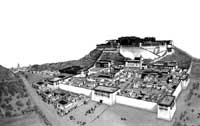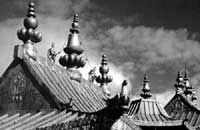|
|
||||
|
A journey to
twelve thousand feet on the discovery |
||||
|
Potala Palace Golden roofs of Tashi Lhunpo |
A journey to Tibet is an important one and as such requires some preparation, both on the physical level and also, on the inner level. As one of the most sacred places in the world, Tibet should be approached with love and respect in order to better receive those spiritual gifts which are to this day given to those receptive to her mysteries. Once in Lhasa, the capital, the first stop is the Jokhang Temple. Heart of Tibetan spirituality, it was built some 1300 years ago by the Buddhist King Songtsen Gonpo. It houses Jowo, the only statue of buddha sculptured during his life which, according to Tibetans, has the ability to fulfill wishes as long as they are just and wise. The sight of masses of pilgrims circumambulating the Temple prostrating, with thousands of butter lamps and incessantly repeating Om Mani Padme Hung - the mantra of compassion - is unforgettable. All around is the Barkhor, one of Tibetís most suggestive and lively markets. The splendid Potala Palace which dominates the city was once the traditional residence of Dalai Lamas. Built in the 15th Century by the 5th Dalai Lama, it is said to count more than a 1000 rooms of which today only about 30 are open to the public filled with splendid sacred objects which belonged to the various Dalai Lamas. Also in the Lhasa area are the three largest monasteries in Tibet, Sera, Drepung and Ganden, which used to house tens of thousands of monks. The most impressive is Ganden some 40km from Lhasa, a journey well worthwhile. Leaving Lhasa behind, the way opens to the mountains through glaciers and turquoise lakes first to the town of Gyantse, with its beautiful market and surrounded by ancient walls; then to Shigatse, the second greatest city in Tibet. Here, in Tashi Lumpo Monastery, the seat of the Panchen Lamas, is an immense statue of Maitreya, which is dedicated to the future Buddha to manifest on the earth. A visit to the stupas beautifully decorated and holding the relics of the past Panchen Lamas is a must. The 10th Panchen Lama who passed away in 1989 was mummified seated in meditation, and for years before his body was eventually locked in the stupa, visitors could witness the continuing growth of his hair. An hour away from Shigatse is the small town of Gangchen where at long last Lama Gangchenís monastery is being rebuilt. Nearby, one can to this day find the sacred lake which is known for revealing images of the future in its still waters to those who have the eyes to see! Enrica Mazzi
Choice flights
|
|||
|
|
||||



